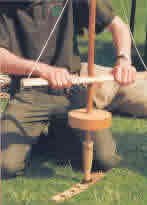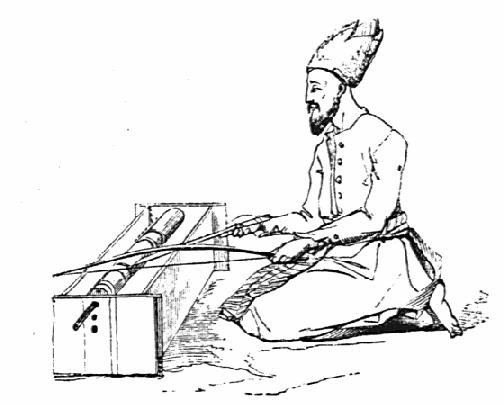All lathes by their very nature rely on a revolving work piece. To capture and impart this motion, to devise and create the required force has challenged mans ingenuity back into pre-history. Man has been using the momentum provided by a spinning weight for tens of thousands of years in the form of drop spindles for spinning wool. The potter’s revolving ‘wheel was almost certainly the first machine used by our ancestors. It maybe that the reciprocating bow drill and pump drill in it’s many forms was the first mechanical hand tool; certainly it could be used to create fire as well as bore holes and with a profiled cutter fitted could be used to produce buttons, counters and beads.

Small lathes driven by a hand held bow probably provided the earliest form of turning
Particularly of small items, not just of wood but Ivory, bone, amber and precious metals. Very fine gold Celtic jewelry has been shown to have been worked on the bow lathe. Bow Lathes also figure in early engineering, especially in clock and watch making.
It is almost certain that the earliest lathes also encompassed reciprocation with the power provided either by the workman himself or with the aid of another individual. The earliest illustration of a lathe is from a well known Egyptian wall relief carved in stone in the tomb of Petosiris dated some 300 BC. As with many Middle Eastern and eastern lathes of this type it was operated at ground level, in this case by two men. Due to standard Egyptian artistic convention each element of the lathe is depicted in the most comprehensible manner for the observer. This results in a misleading depiction as it appears to show a vertical lathe when in fact what is intended is a horizontal strap lathe. One man provides the power by pulling backwards and forwards on a cord or leather strap wrapped around the work piece while the turner sits opposite with his chisel on the tool rest.
At a similar period, the Iron Age inhabitants of the Glastonbury Lake villages have been shown to be very competent woodturners. Excavations show these English West Country Celts to have produced some quite sizable turned artifacts such as spokes and hubs for wheels. Mallets, bowls, tool handles as well as smaller items like stoppers for jars are among items recovered by amateur archaeologist Arthur Bullieid and Harold St George Gray over a century ago. No actual lathe evidence was discovered and so one can only make assumptions. Strap or bow lathes could have been used for the smaller artifacts but turning wheel hubs would require more power than would probably be available from a strap lathe. It is almost certain that pole lathes were used to produce the larger items.

The Romans were familiar with the wood turning lathe, they were particularly adept at making very fine lidded boxes and containers from boxwood, and there was also a demand for sophisticated furniture parts for couches and such. In Dorset they were turning Shale, a soft stone from the Kimmeridge area into body adornments such as amulets.
Archaeological excavations at York uncovered over-whelming evidence that wood-turning played a significant role in daily life during the Viking period of occupation. The Vikings were great artisans and natural woodworkers, and most every day domestic items were fashioned from wood. It seems everyone used wooden bowls in York; these were turned in small timber buildings behind the houses fronting the streets. Apart from complete bowls many ‘cores’, the waste centre pieces remaining after being turned on a pole lathe, were found. These cores and the discovery of part of an adjustable tool rest provided enough clues as to what the lathe looked like and how it functioned. It is interesting that even in modern time’s parallels can be found. George William Lailey in Berkshire was using a virtually identical bowl turning lathe until 1958. Even today Ion Constantin works in just the same fashion in his Romanian back yard.
The earliest illustrations of a pole lathe occur in the 13th century
A very stylized stained glass window in Chartres Cathedral clearly depicts what looks like a woman seated at the lathe complete with cord and foot treadle. A much more precise rendition is to be found in a French illuminated manuscript. Again the turner appears to be a woman and the lathe components themselves seem to be turned and decorated with bead ornament.

A German family called Mendel founded a home for aged craftsmen in 1388. In 1425 the family instigated a ‘house book’ in which a full-page portrait was incorporated of each deceased artisan including a Pole Lathe turner. The turners lathe bed of a solid ‘table top’ type made up of a single plank of wood is unusual although there was a tradition in Wales for this design last century! The artist has captured the broad chisels and skew very well but has omitted the tool rest.
The Book of Trades published in Nuremberg in 1568 includes a woodcut of what we might call a production tuner. His workshop faces the street and also serves as a shop front. He seems to be using mostly hook tools judging from those hung on the rack behind him and the position of the tool he is using. The range of the turner, if this pictorial view is representative is enormous. The German text says: “The turner makes little jewel boxes of Boxwood, cases, pulpits. Bedposts, hammer handles, bowling pins and mallets. He is shown making a bowling pin, also in his ‘shop’ are dishes, furniture legs, a flute and drinking flasks turned on double axis. All this illustrates the versatility and importance of the pole lathe in a thriving medieval city.
If space for a pole was limited, perhaps by a low ceiling a bow and ‘shreave’ was some times used as a substitute from the late 17th century. An archery type bow with several strings (‘Cat gut’) passing through a bobbin (the shreave) on to which the lathe line was attached. As the foot treadle was depressed the Shreave revolved, wound up the bow cord and in doing so applied enough tension to the bow to provide for the upward return of the treadle. This was a temperamental and sophisticated alternative to the spring pole with the only advantage of compactness. It had the additional disadvantage of restricting the movement of the cord to any desired area of the work. The simple pole was much more versatile.

In his book, ‘Hand or Simple Turning’ John Jacob Holtzapffel illustrates a Chinese pipe stem turner using another form of reciprocal motion. After the drive cord is wound round the driving mandrill the two ends terminate at separate foot pedals. The operator works seated and pumps the foot pedals alternatively, such a lathe is only suitable for light work.

In the same book Holtzapffel describes an itinerant strap lathe turner who sets up his crude lathe wherever the job might be. If a customer needs to replace a broken furniture part for instance the turner commences by ramming two low posts into the ground at the required distance apart and to tie a horizontal tool rest to them. Round nails or spikes are driven through the posts to act as centres. A boy is engaged to pull on the ends of the coca-nut rope that is wrapped round the work in alternative directions. The turner then sits on the ground holding the turning tool in both hands and manipulates the cutting edge with his toes.
What may seem surprising to many people is the long continuous history of using reciprocating lathes: one might think that the early use of the wheel would have had a more significant impact. It is impossible to write a chronological history of the lathe expecting each new advance to supercede the last and completely replace it; life is not that simple. Jan Joris Van Der Vliet’s etching of 1635 shows a Dutch spindle turner at his Pole Lathe, a lathe identical to those used commercially in the Beech woods of England less than 50 years ago and still used by some craftsmen today. Indeed there is a renaissance; the association of Pole Lathe Turners (UK) enjoys a membership of over 350 enthusiasts.
